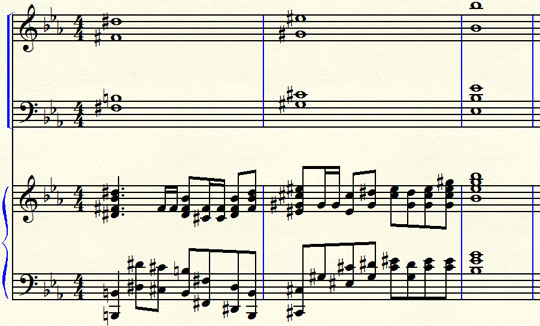Free Lessons
A tip for sight reading
I am taking a break this week from reharmonization examples. I was planning to record some but broke a string on my piano, and until it gets fixed later in the week, I can’t really record anything. But here is something else you might find helpful about sight reading.
By no means am I an expert sight reader. Actually, I don’t even read music much any more except when I accompany. But when I am home, I accompany our choir, and I end up sight reading all of that music on the spot. I am not necessarily proud of that fact, but I am practicing a ton right now on other stuff and just don’t have a lot of time to practice choir music.
This morning, I played some music that ended with these three bars.

Frankly, I am not good enough to sight read this kind of music perfectly. There are too many accidentals and such. So I cheat. Today, I am going to tell you how I cheat. Learn this, and you can fake it too.
There are two parts to how I think about this. First, I want to identify the chords the choir is singing and understand them in the context of the song. The first bar is a B major chord and the second bar is a C# (or Db) chord.
In the context of the song and key, B major is a borrowed chord that might be labeled bVI. That chord can pretty much resolve to any diatonic chord in Eb. I would have preferred to see the second bar expressed as a Db chord rather than C# because that chord is the very popular bVII chord that you see constantly in church music. It resolves to the I chord (Eb).
Don’t worry if you did not understand my last paragraph. Really, you simply have to recognize that you are playing a B major triad in the first bar and a C# (or more accurately, Db) major triad in the second bar. At that point, you can simply ignore the piano accompaniment.
Perhaps the word “ignore” is too strong. What I really do is notice the general form of the accompaniment and play something similar. In this case, I just play a few big rhythmic patterns on a B major chord and then a Db chord.
That is all there is to it. No more accidentals and no more sight reading heartburn.
This is why chord identification (charting) is so important. If you can read chords in real time like this, you will improve your sight reading skills exponentially. Of course, at that point, you are not really sight reading any more, but no one will know the difference.
